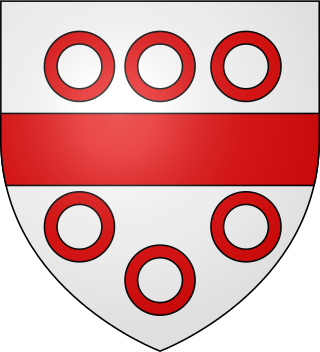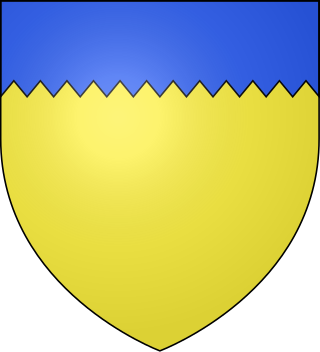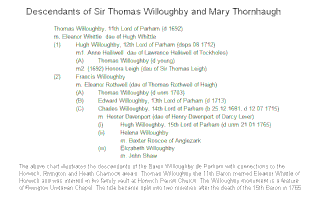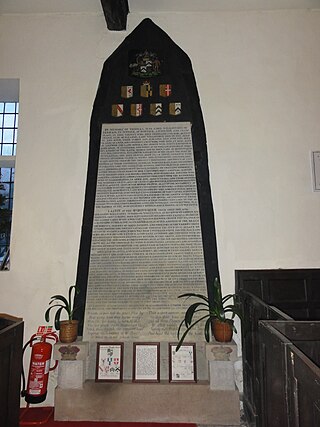Related Research Articles

Baron de Ros of Helmsley is the premier baron in the Peerage of England, created in 1288/89 for William de Ros, with precedence to 24 December 1264. Premier baron is a designation and status awarded to the holder of the most ancient extant barony of the Peerage of England. Before the Dissolution of the Monasteries the Prior of the Order of St John in England was deemed the premier baron.

Viscount Cobham is a title in the Peerage of Great Britain that was created in 1718. Owing to its special remainder, the title has passed through several families. Since 1889, it has been held by members of the Lyttelton family.

Baron Lucas is a title that has been created twice in the Peerage of England. The second creation is extant and is currently held with the title Lord Dingwall in the Peerage of Scotland.

Baron Saye and Sele is a title in the Peerage of England held by the Twisleton-Wykeham-Fiennes family. The title dates to 1447 but it was recreated in 1603. Confusion over the details of the 15th-century title has led to conflicting order for titleholders; authorities such as Burke's Peerage and Debrett's Peerage do not agree on whether or not the 1447 creation is still extant.

Earl of Wilton, of Wilton Castle in the County of Herefordshire, is a title in the Peerage of the United Kingdom. It was created in 1801 for Thomas Egerton, 1st Baron Grey de Wilton, along with the subsidiary title of Viscount Grey de Wilton, also in the Peerage of the United Kingdom. Both titles were created with remainder to the second and all younger sons successively of his daughter Eleanor, wife of Robert Grosvenor, 1st Marquess of Westminster.

Baron Middleton, of Middleton in the County of Warwick, is a title in the Peerage of Great Britain, created in December 1711 for Sir Thomas Willoughby, 2nd Baronet, who had previously represented Nottinghamshire and Newark in Parliament. It was one of twelve new peerages created together and known as Harley's Dozen, to give a Tory majority in the House of Lords.

There have been three baronies created for the Gerard family who lived historically at Bryn, Ashton-in-Makerfield, Lancashire and Kingsley, Cheshire, in the 13th century. The third and current barony was created in 1876.
The title Baron Latimer or Latymer has been created, by the definitions of modern peerage law, four times in the Peerage of England. Of these, one was restored from abeyance in 1913; one is forfeit; the other two are dormant, although their heir is well known.
There have been two baronetcies created for people with the surname Heathcote, both in the Baronetage of Great Britain and both created in 1733. The holders of the first creation were later elevated to the peerage as Baron Aveland and Earl of Ancaster, which titles are now extinct. However, both baronetcies are extant as of 2008.

William Willoughby, 1st Baron Willoughby of Parham was an English nobleman and soldier who in 1547 was made an hereditary peer of the House of Lords.
Roger Stafford, 6th Baron Stafford, was the son of Richard Stafford, a younger son of Henry Stafford, 1st Baron Stafford, and Ursula Pole. He was forced to give up the Stafford barony in 1637 on the grounds of poverty.

Charles Willoughby, 2nd Baron Willoughby of Parham was the only son of William Willoughby, 1st Baron Willoughby of Parham, and Elizabeth Heneage.

Butler is the name of a noble family whose members were, for several centuries, prominent in the administration of the Lordship of Ireland and the Kingdom of Ireland. They rose to their highest prominence as Dukes of Ormonde. The family has produced multiple titles such as Baron Cahir, Baron Dunboyne, Viscount Ikerrin, Viscount Galmoye, Viscount Mountgarret, Viscount Thurles, Earl of Carrick, Earl of Kilkenny, Earl of Ormond, Earl of Ossory, Marquess of Ormonde and Duke of Ormonde. Variant spellings of the name include le Boteler and le Botiller. The Butlers were descendants of Anglo-Norman lords who participated in the Norman invasion of Ireland in the 12th century. The surname has its origins in the hereditary office of "Butler (cup-bearer) of Ireland", originating with Theobald Walter, 1st Chief Butler of Ireland. The arms of later family members depicted three cups in recognition of their original office.

Baron Willoughby of Parham was a title in the Peerage of England with two creations. The first creation was for Sir William Willoughby who was raised to the peerage under letters patent in 1547, with the remainder to his heirs male of body. An error in identifying the heir in 1680 resulted in an inadvertent novel creation by writ in 1680, without the restriction on inheritance by gender. The creation of the barony gave the right to a hereditary peerage and seat in the House of Lords, the upper house of Parliament.

Thomas Willoughby, 11th Baron Willoughby of Parham (c.1602–1691/92) was an English peer of the House of Lords. He was born in about 1602, son of Sir Thomas Willoughby and Mary Thornhaugh (Thornley), and grandson of Charles Willoughby, 2nd Baron Willoughby of Parham and Lady Margaret Clinton.
Hugh Willoughby, 12th Baron Willoughby of Parham (c.1637–1712) was an English peer of the House of Lords. He was the eldest son of Thomas Willoughby, 11th Baron Willoughby of Parham and his wife Eleanor, daughter of Hugh Whittle of Horwich. He succeeded to the title on the death of his father in 1692.

Hugh, 15th Baron Willoughby of Parham was an English nobleman and hereditary peer of the House of Lords. He was born in 1713, the eldest son of Charles Willoughby, 14th Baron Willoughby of Parham and Hester, daughter of Henry Davenport of Little Lever and Darcy Lever, near Bolton. Hugh Willoughby's father died on 12 June 1715, aged 34, and the infant Hugh Willoughby became the 15th Baron Willoughby of Parham. He could not take his seat in the House of Lords until he reached the age of 21.
Edward Willoughby, 13th Baron Willoughby of Parham (1676–1713) was an English peer of the House of Lords. He was the son of Francis Willoughby (1676–1704) and Eleanor, daughter of Thomas Rothwell of Haigh. Francis was the younger brother of Hugh Willoughby, 12th Baron Willoughby of Parham who died without a male heir. Edward Willoughby was in military service with the Duke of Marlborough's regiment in Flanders when he died, unmarried, aged 37 in 1713. The administration of his estate was granted to a creditor, his mother and brother having renounced.
Henry Willoughby, 16th Baron Willoughby of Parham was an English peer of the House of Lords.

Ralph Grey, 2nd Baron Grey of Werke was an English peer.
References
Notes
- ↑ Burke 1831 , p. 576
- 1 2 3 Burke 1831 , p. 577
- ↑ The Records of a Lancashire Family - Shaw
- ↑ Willoughby Monument at Rivington Unitarian Chapel
- ↑ Hampson 1893, p. 70.
Bibliography
- Burke, John (1831), A General and Heraldic Dictionary of the Peerage of England, Ireland and Scotland, London: Henry Colburn and Richard Bentley.
- Cunliffe-Shaw, R. (1940), Records of a Lancashire Family, Preston: The Guardian Press Limited.
- Smith, M.D. (1989), Rivington, Lancashire, Chorley: Nelson Brothers Printers Limited, ISBN 0-9508772-8-X .
- Hampson, Thomas (1893), History of Rivington: With Lists of the Clergy and Church Wardens, the Church Wardens Accounts, Particulars of the Rivington and Blackrod Grammar